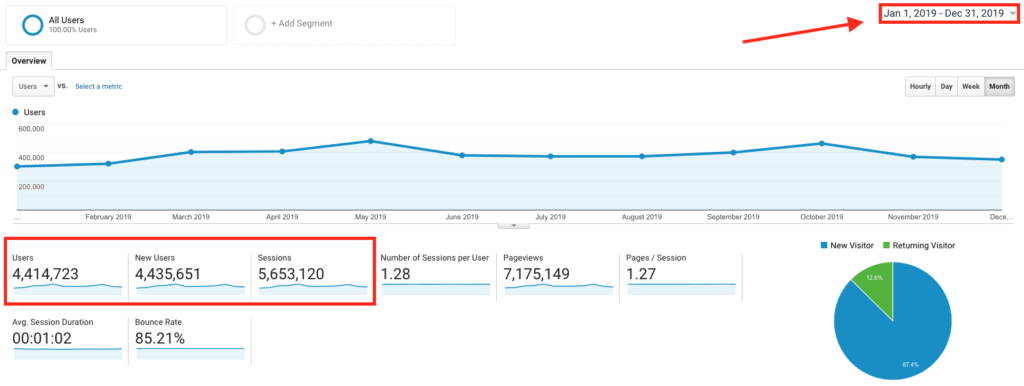Why? Well, having a grasp on the most current blogging statistics and facts can help you identify gaps where you can create more strategic content that’ll stand out from your competition.
Analyzing the data behind what’s working well for other bloggers can also help you pinpoint your own content shortcomings, gather insightful ideas to test or determine the best way to start a blog of your own. Moreover, regardless of the industry you’re in, these blogging statistics will help you improve your content strategy moving forward.
So, is blogging overrated? Is it really the secret sauce to driving traffic that many claim it to be? While my answer is a bit biased, having built multiple businesses powered by blogging stats & strong results like these, one thing is certain. Many other successful businesses and bloggers are investing a lot of resources into blogging. But, I’m getting ahead of myself.
To prove (or disprove) the value of blogging, let’s quickly look at these 45 blogging statistics & facts that’ll shed a clear light on the state of blogging in 2025.
Content is still the pillar of all inbound marketing efforts. And in most cases, the foundation on which that pillar is built… is a blog. Hence why these blogging facts and statistics will be so helpful in driving your content strategy toward strong results this year.
Disclosure: Please note that some of the links below are affiliate links and at no additional cost to you, I’ll earn a commission. Know that I only recommend products and services I’ve personally used and stand behind. When you use one of my affiliate links, the company compensates me, which helps me run this blog and keep my in-depth content free of charge for readers (like you).
Ready to Start Your Blog?
Check out my ultimate guide: How to Start a Blog (on the Side) Today.
Here’s a collection of my picks for the most insightful blogging statistics you need to know in order to create successful content this year. Whether you’re new to blogging, or a seasoned marketer, these blogging statistics will help immensely in mapping your blogging journey into the future.
The State of Blogging: General Blogging Statistics & Facts in 2025

Let’s start our journey down the path of blogging statistics with a casual glance at the state of blogging, shall we?
1. A whopping 43% of all websites on the Internet are powered by WordPress as their content management system of choice. (W3 Techs)
2. 70 million. That’s the average number of new posts published on WordPress in a given month. (WordPress Activity)
If you’re interested in starting a blog and haven’t considered self-hosted WordPress, it’s by far the best blogging platform that allows for the most customization, flexibility and monetization options over time. Check out these blog examples for more inspiration and if you have any questions, please leave a comment below!
3. More than 409 million people view over 20 billion pages each month on WordPress.com alone. (WordPress Activity)
That’s a LOT of Internet users turning to blog content for answers. Keep in mind that these blogging stats are specific to just one small segment of the WordPress business, the portion of blogs they host themselves—and the vast majority of bloggers (and blogs) on the Internet use self-hosted WordPress instead.
4. On average, it takes about 4 hours to write a blog post. (Orbit Media)
Believe it or not, writing a blog post that can actually deliver meaningful value to readers… takes time. Though it can help immensely if you have a started set of blog post templates to hit the ground running each time you sit down to create content. My free blog planner bundle will help immensely with that process, too.
5. 52 seconds. That’s the average time a reader spends reading a blog post. (Klipfolio)
I know what you’re thinking—only 52 seconds?! That’s abysmally low, especially considering that most blog posts weigh in at well over 1,000 words (and content that ranks higher on Google is often a good deal longer).
Don’t let this blogging statistic scare you though, as there are many things you can do as a blogger to simultaneously increase the amount of time readers spend on your articles while also writing stronger blog posts (or even guest blogging to get backlinks) that provide more value to those readers.
To increase the time people spend on your blog posts:
- Add as much value into a blog post as possible. People don’t read blog posts simply for entertainment—they read to find a solution to a particular problem.
- Create skim-friendly content. In other words, break up your text into easily digestible chunks and use bullet points in your content formatting (like these lists).
- Utilize a combination of written content, images, embedded video content and audio to keep readers engaged (and appeal to the learning styles of more people).
6. Blog posts that feature an image every 75-100 words get 2X more shares than those without. (HubSpot)
There’s a strong case to be made for including a lot of visuals throughout your blog posts. Don’t limit yourself to just stock photography though—consider creating custom images, graphics, icons and infographics that can entertain your blog readers visually.
7. There are approximately 600 million blogs in the world in 2024. (Internet Live Stats)
Believe it or not, the number of blogs (and number of bloggers) grows significantly every day. While the vast majority of blogs run on blogging platforms like WordPress and Ghost, there are still a lot of free blog sites like Tumblr, Wix, Weebly, Medium, LinkedIn and Blogger that are popular with bloggers in different areas of the world.
8. On average, about 3.2 million new blog posts are published every day. (Internet Live Stats)
9. An overwhelming 77% of Internet users regularly read blog posts. (Impact)
A casual look at the number of blog posts being published in a single month shows just how competitive blogging is becoming—and if you’re wondering, do people still read blogs? the answer is a resounding yes. Pro tip: To boost your blog traffic and domain authority in the early days, pitch guest posts to other blogs in your industry that already have the readers you want to reach (in the blogging industry, guest blogging is a common, established practice).
10. YouTube is the most visited website in the world with 3.9 billion monthly visitors. (Ahrefs)
Don’t sleep on video content, because it’s the future of blogging. If you’re tight on time (or resources) and considering blogging vs YouTube videos for your content creation, my advice is to attempt combining the two as best as you can.
11. Over 1 billion hours of video content is watched on YouTube every single day. (YouTube Press)
I hope these blogging stats have shown you the importance of publishing content online—so if you haven’t started investing in content for either your personal blog or business growth yet, these blogging statistics clearly highlight that now is still the perfect time to get started.
Ready to Start Your Blog?
Check out my ultimate guide: How to Start a Blog (on the Side) Today.
Length and Frequency-Related Blogging Statistics

Do blog post length and frequency of publishing impact the success of your blogging efforts? (Hint: Yes they do and we’re going to dig into these blogging facts to learn why.)
Check out these blogging statistics to help shape your blogging strategy when it comes to blog post length and posting frequency:
12. The average blog post length is 1,394 words in 2024. (Orbit Media)
While this blogging fact may sound low to those well-versed in the content world, the average blog post length weighs in at just 1,416 words. And while this average length figure may sound like a lot to some, it’s a far cry from my recommendation on the ideal blog post length, which tends to be 2,000 – 2,500 words depending upon the topic at-hand.
13. Only 13% of bloggers write blog content that’s 2,000+ words in length. (Orbit Media)
14. The optimal length for a blog post is in the 2,250 – 2,500 word count range. (HubSpot)
Long-form content is the way to go if you hope to enjoy a strong ROI from your blogging efforts, so don’t be shy of getting your word count up above the 2,500+ range for your blog content.
15. 35% of bloggers report publishing new blog content between one to six times per week. (Orbit Media)
According to these blogging statistics on frequency and post length, it’s better to post longer (more comprehensive) content with less frequency in today’s content world. And because not all bloggers have caught on to this insight about the effectiveness of long-form content, that’s a gap you can still leverage to create standout content.
Marketing-Focused Blogging Statistics

Many marketers report blogging as being an integral part of their entire inbound marketing efforts (to bring potential customers to their websites).
Here are some marketing-specific blogging statistics that’ll help you prioritize where to focus in your content marketing for 2025.
16. 65% of content marketers say they have a documented content marketing strategy to guide their efforts. (CMI and MarketingProfs)
That’s a significant jump considering only 39% documented their content marketing strategy in years prior. It’s a sure sign that more businesses are appreciating the value blogging can create for their bottom lines.
17. 71% of B2B buyers consume blog content during their buyer journey. (Demand Gen)
Blogging is no longer simple a top of the funnel inbound marketing strategy (and marketing statistics like this prove the case). When properly utilized, you can put blogging to work in the middle and at the end of your sales funnel, to help answer critical questions, reinforce credibility and guide your prospects into sealing the deal.
18. Blogging influences 6% of eCommerce sales (and doubles to 12% for businesses that blog regularly for 12 months). (Matcha Benchmark Report)
If you’re thinking of adding a blogging component to your eCommerce store, be sure to choose one of the eCommerce website builders that functions well in tandem with a blog (like Shopify, WooCommerce or Squarespace). For even more, check out Tidio’s great resource for understanding customer trust and turning website visitors into sales.
19. Companies that publish 16 or more blog posts per month generate 4.5X more leads than those that publish 4 posts (or less). (HubSpot)
That means you’ll need to regularly come up with compelling, clever and engaging blog post ideas that still relate back to the overall mission of attracting readers who can eventually convert into becoming email subscribers—and you can leverage email marketing to convert them into customers for your business.
20. 600 million devices had ad blockers installed on them in 2016 alone. That number has been growing by a whopping 40% every year. (Think with Google)
Bloggers that generate an income from traditional blog ad networks are dying a slow death. Savvy marketers have already seen these blogging trends coming, and have pivoted to monetizing their blogs through other more sustainable sources like affiliate marketing, sponsored content, online courses, selling their services and more—to boost the income bloggers can expect to generate.
21. Content marketing is 62% cheaper than traditional marketing. (Demand Metric)
22. When it comes to lead generation, content marketing produces 3X more leads than paid search. (Kapost)
23. 60% of people cite purchasing a product after originally reading a blog post about it. (Demand Metric)
24. 89% of B2B marketers cite content marketing as a very important marketing strategy. (Content Marketing Institute)
25. More than 92% of marketers consider content as a valuable asset worth investing in. (Content Marketing Institute)
26. Close to 50% of marketers say, given the chance to start their content marketing over, they would focus on blogging. (Databox)
27. 61% of Americans spend 3X more time consuming blog content than they do email content. (Social Media Today)
While blogging statistics like this can make it sound (on the surface) like email isn’t as great of a channel to reach your target audience—don’t let that de-prioritize your email marketing efforts, as they apply to other key blog promotion channels like doing smart blogger outreach to build strategic relationships.
28. 75% of online shoppers say they use social media as a part of their buying process. (Social Media Today)
It’s official, and the data proves it—businesses that don’t blog (and promote their content on social media) are at great risk of closing shop in the long run as per the most recent online shopping statistics available.
From lead generation to educating your prospects, blog posts are an excellent, effective and economical way of driving your business forward—suggesting that it should lead an integral role in your overall blog business plan, too. Plus, blogging is a way to build meaningful relationships with your future customers while they’re still in the process of learning about your product.
29. The average CPC for content ads on Facebook is 96% lower than the cost of all non-content ads. (Matcha Benchmark Report)
These blogging statistics reinforce the fact that it’s a long-term investment to take on blogging as a customer acquisition strategy—but the rewards are often incredible for the companies (and people) that fully commit to using their blog content as a way to drive massive business growth.
SEO (Search Engine Optimization) Related Blogging Statistics

Let’s quickly take a look at some SEO and blogging statistics you need to know in 2025.
These will be particularly helpful in seeing what it takes to rank your blog content high in organic search results, increase brand awareness and bring in more readers from search engines.
30. Google has a 92.04% search engine market share. Yahoo! Comes in second with 2.67%. (StatCounter)
31. Lengthwise, top ranking content on Google averages between 1,500-2,500 words. (ryrob)
Considering that the average post length in 2014 was 808 words, that’s pretty massive increase in less than ten years. Again, this blogging statistic is an indicator of how competitive it’s becoming for bloggers to create content that stands out from the competition.
32. A whopping 58.6% of all website traffic worldwide is from mobile devices. (Statista)
Mobile blog traffic is up by more than 2% over the previous year, and that rate is only climbing as we dive further into 2025. That makes the use of responsive WordPress themes with thoughtful blog layouts, smart mobile-optimization of your content, speedy loading—and employing only the best web hosting plans more important than ever before.
33. Having a blog on your website increases your chances of ranking higher in search by a massive 434%. (Tech Client)
34. Driving traffic to their websites is a major marketing priority for 54% of marketers. (HubSpot State of Marketing)
35. Increase in traffic is proportional to an increase in publishing blog posts. Once you publish 21-54 blog posts, your blog traffic can increase by as much as 30%. (Traffic Generation Cafe)
36. Up to 80% of searchers ignore sponsored posts in favor of organic content. (MarTech)
37. 95% of searchers never go past the first page of Google’s search results page, making it the most valuable piece of real estate on the Internet. (Brafton)
38. 50% of search queries are four words or longer. That means over half of search queries are for something specific. (Brafton)
39. Close to half of all clicks on the SERPs (search engine results pages) go to the top 3 listings. (Ignite Visibility)
Blogging is the backbone of an effective SEO strategy—because it’s the content you create on your blog that stands a higher chance of ranking for competitive keywords (if you learn how to do keyword research, that is). To maximize your ability to rank your content high in search results, Google and the other major search engines demand content that’s:
- Expertly written
- Authoritative
- Trustworthy
The only way your website can meet the E.A.T. criteria and find favor in Google’s eyes (thus getting organic traffic from the search engine), is by regularly publishing high quality content (related to the topics you’re a perceived expert at) on your blog. Nailing this SEO tenant will not only help you rank higher on Google, but it also helps establish yourself as a reliable source of information on the subjects you specialize in.
40. Retailers in the U.S. expect to spend upwards of $6.8 Billion on affiliate marketing programs in 2023. (Awin)
This blogging statistic is particularly relevant today, because it’s indicative of just how much room for growth there still is for bloggers that are just getting started today. While it may seem that there’s already too much competition in your blog niche—there’s still room for dramatic growth to be had within many of the top affiliate programs in the world.
The Impact of Headlines on Blog Posts (Blogging Statistics)

My roundup of the most important blogging statistics you need to know in 2025 just wouldn’t be complete without a deep dive on what it takes to write blog headlines that’ll convert. Headlines are not only a crucial component of capturing the attention of potential readers wherever they may be, but also for consideration to become a top-ranking article by search engines.
Need Catchy Blog Title Ideas?
Try my free AI-Powered Blog Title Generator Tool to get dozens of SEO-friendly headline ideas to make your blog posts stand out today.
41. Evergreen content is fast fading in B2B circles. Predictive headlines (“The Future of…”) are fast outperforming all other types of content. (BuzzSumo)
Check out my ultimate guide to creating evergreen content if you want to make sure you’re doing it right (and maximizing your chances to drive traffic to your blog posts). Keep in mind though, that there are lots of different types of content like listicles, roundup posts, how-to tutorials, step-by-step walkthroughs, pillar content guides and plenty of others that you should consider creating (and many different types of blogs, for that matter).
42. Blog posts with 6-13 word long headlines tend to drive more traffic. (HubSpot)
43. When it comes to numbered headlines, odd numbered headlines perform better than their even numbered counterparts. (Content Marketing Institute)
44. Emotional headlines get a higher number of shares than other headline types. (OkDork)
In order to get readers to click into your blog post in the first place, you’ll have to nail your blog headline.
Consider your headline as the welcome mat to your specific blog post, so it naturally pays to invest a little time into writing titles that’ll attract more readers.
If your headline is interesting enough, readers won’t hesitate to visit your blog and see what you have to offer (and it’ll help you drive traffic)—just be sure to work hard on matching the user-intent of what those readers are there to achieve. Make it as easy as possible for them to get what they came for, and you’ll win the race to the top of search rankings over time, and thus winning you more organic traffic.
45. Blog posts are 3.5 times more likely to get shared on social media by my email subscribers. (me 🙂)
Blogging statistics like this one, are based on crunching the numbers from my own email marketing list of 140,000+ subscribers and the more than 4.4 million readers I saw last year alone. And I’ve learned that my blog posts get more social shares when I send an email marketing message to all of my subscribers.

If you want to learn more about how I’ve grown my own blog to becoming a full-time, successful blog business, pick up my free blogging books and blogging courses that dive deep into my journey.
Alright, now let’s talk about some of the key takeaways from these blogging statistics we’ve broken down here today. Because with thoughtful blogging goals that connect to a coherent blog strategy, you’ll be able to use these blogging facts and trends to create higher traffic content for your site this year.
Key Takeaways from These Blogging Statistics

So, at the end of this all, what do these blogging statistics really tell us?
Here are a few important takeaways to consider:
- Blogging is a powerful way of reaching and engaging with your audience
- Business blogging is a marketing channel (when it’s consistent) that outperforms many other lead generation channels
- Companies that invest real budgets into content creation and digital marketing efforts, outperform those that don’t
- The costs of blogging are incredibly low as an acquisition channel (especially if you have a cheap hosting plan)
- Long-form content is the most popular and profitable type of blog content (so aim for 1,500+ words in your articles)
- A strong blogging strategy is key to driving traffic to your website
- Blogging is an integral part of lead generation and selling today
If your business isn’t blogging, you’re missing out on a lot of lucrative opportunities (as highlighted by these insightful blogging statistics).
Most of all, as blogging only gets more popular and competitive as we move into the future, the best time to start taking it seriously is well… today!
Use My Free Keyword Research Tool

Try my free AI-Powered Keyword Tool to get dozens of research-backed ideas for keywords & topics to write about on your blog today. And be sure to check out my blog title generator tool as well.
My call-to-action for you after reading these blogging statistics is to do something about it (create better blog content).
Rather than simply reading about all of these blogging statistics and moving on with your day, transform this data into the strategic components of your own blogging and content creation endeavors. To help better accomplish that goal, check out my best resources for creating a long-lasting blogging strategy:
- How to Pick a Niche to Blog About (+8 Profitable Niche Blog Ideas)
- 8 Best Monthly Hosting Plans (Month-to-Month Payment)
- How to Make a Website in 3 Easy Steps
- How to Create a Smart Content Marketing Strategy
- 201+ Clever Blog Post Ideas That’ll Bring Readers to Your Website
- How to Write a Blog Post (People Will Actually Want to Read)
- 40 Blogging Tips From the World’s Top Bloggers
- 21 Blogging Mistakes (and How to Avoid Them)
- How to Write an eBook (and Sell Copies Online)
- 25 Bluehost Reviews (Honest Compilation of Reviews)
- How to Start a Podcast and Make Money (on the Side)
- 23 Best Podcast Hosting Platforms (Free and Cheap)
And if you haven’t gotten started on your blogging journey yet, there’s no better time than today. Read through my comprehensive step-by-step guide to starting a blog to get up and running in a matter of just minutes.
If we’ve learned anything from these blogging statistics, is that real businesses are thriving as a result of blogging.
With enough time, effort and creativity, your blog can even turn into a source of meaningful income on its own (see how much bloggers can make)—just be sure you’re setting yourself up to handle your blog taxes too.
Ready to Start Your Blog?
Check out my ultimate guide: How to Start a Blog (on the Side) Today.

139 replies to “45 Blogging Statistics & Facts to Know in 2025 (and Be a Smarter Blogger This Year)”
Thank you for sharing this knowledge of blogging. Certainly very useful for beginners in particular
Its not my first time to pay a quick visit to your blog, Ryan! Love that you’re getting into sharing more of this kind of data behind blogging now.
Thanks so much, Kirk! 🙏
Thanks for popping by!
Thank you very much for compiling and sharing these statistics!
Woo! You’re welcome Judy 🙂
Simply the best insights i ever read. It gives me hope to work on my websites more and do somthing for the people they need.
Boom! Thanks for sharing <3
Thanks for putting this together Ryan! On a tangent, would you know of the blogs’ readership stats? Readership by age, city/state, demographic, etc.
You’re welcome! You mean do I know *my* blog’s readership statistics… or if there’s available data on the readership statistics of blog readers worldwide?
Good stuff Ryan!
Bookmarked as a blogging resource. 😀👍🏻
Thanks for stopping by, Tommy! 🙂
Blogging is getting more and more challenging which is why we bloggers need to stay updated about the latest blogging trends. Ya, some more hard work, besides writing great content 🙂
Yes, indeed! Always more hard work to be done in order to truly differentiate yourself from the other bloggers in your niche 🙂
Great post! Never seen anything like this. A scientific analysis of how a blogger should keep this information in mind in order to be known faster and to as many people as possible.
You’ve got that right! 💪
Very helpful, thanks Ryan
You’re welcome, Leah!
Fairly enough.
🙌
Great post Ryan… I just started a blog on technology to give insights to the user about all the tech buzz. I was looking to write and publish my 1st blog post and fortunately I came across this post which I found really helpful to craft my 1st and further posts. With this I think I would be able to write more appealing post for my upcoming audience. Thanks a ton for sharing your knowledge in such a great manner.
You’re welcome, Vinit! Glad you found these statistics so helpful in creating your first pieces of content 🙂
Hi Ryan Robinson, this information is invaluable! I’ve been reading a couple of your articles over and over again. I’m a complete newbie to all of this and am having trouble finding a niche. I’ve been playing around with the free seo websites but don’t really understand the marketing lingo. i’m not sure what cpc number to look for, backlinks, domain score… This is all a foreign language to me. Anyway, do you have an article that breaks all of this down a little more? In the meantime, I’ll keep combing through your website. Thnaks for what you do!
Nice! Thanks for the kind words, Alex. Have you gone through my ultimate guide to finding the right blog niche? https://www.ryrob.com/blog-niche/
My advice is to not worry so much about all of the terminology like CPC, backlinks, domain score, etc for now. The important thing for you to do at this stage is start taking action toward figuring out a meaningful topic (to you) that you can write about—where there’s also demand in the real world in terms of people searching for answers on the subject. My guide to starting a blog is a step-by-step progression for all of this: https://www.ryrob.com/how-start-blog/
Very very very helpful information. thanks for sharing, keep it up!
You’re welcome! So pumped to be helpful, Naeem 🙂
Very usefull information thanks for sharing keep going.
You’re welcome, Sehaj! Stay tuned for more.
Thank you for sharing these figures. Very informative and useful content!
You’re welcome, Jack!
Thanks a lot Ryan for these mind blowing blogging statistics. I just launched a blog and will keep coming back to refine my knowledge.
You’re welcome, Nkanu! Good luck with your new blog.
Right now, the algorithms working at the backend of Google have immensely changed. With the latest update, Google now favors the usefulness of the content and the amount of information delivered instead of just strategically placed keywords. With the right information, you are able to get a much better chance of ranking your website on the top place in Google than stuffing keywords.
Absolutely! I couldn’t agree more 🙂
Thank you for your tips Ryan. I do agree that blogging is the backbone of an SEO strategy. Your updated tips on blogging can help bloggers to drive traffic to their blog. Seriously these blogging statistics are a bit shocking, but quite interesting as well. All your tips are exactly acceptable—like a post with image get 2X more shares than those without.
You’re very welcome!
Nice and valuable information for beginners like me. Thanks for sharing.
You’re welcome!